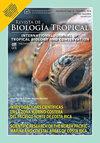Silage quality and bacterial diversity of silages inoculated with Listeria monocytogenes and Lacticaseibacillus paracasei_6714
IF 0.6
4区 生物学
Q4 BIOLOGY
引用次数: 1
Abstract
Introduction: King grass (Cenchrus purpureus (Schumach.) Morrone, syn. Pennisetum purpuphoides) and pineapple peel (Ananas comosus) silages are food alternatives for livestock in conditions of feed shortage. Objective: To describe the dynamics of the microbiota present in king grass and pineapple silage during the fermentation process using next generation sequencing (NGS) and to evaluate the protective effect of Lacticaseibacillus paracasei_6714 as a silage inoculum against Listeria monocytogenes. Methods: We used an unrestricted randomized design to characterize the microbiota present in silages made from king grass harvested 70 days after regrowth and pineapple peel. We inoculated mixtures of grass and peel with L. paracasei_6714 or L. monocytogenes, or both, with a non-inoculated treatment as control. The nutritional and fermentative profile was evaluated after 30 days. After 15 and 30 days of fermentation, we used 16S rRNA analysis to determine the dynamics and diversity of the microbiota in the inoculated and control silages. Result: Dry matter content and digestibility did not differ significantly; however, there were differences in crude protein, pH and organic acids. We obtained 4432 amplicon sequence variants of Proteobacteria, Firmicutes, Bacterioidetes, Actinobacteria, Verrucomicrobia, Planctomycetes and Patescibacteria. The relative abundance of each phylum varied depending on the material and fermentation period. Phylum similarity was over 70 % (but not greater than 50 % with Bray-Curtis at the species level). Conclusion: These bacterial communities seem to have an important role during silage fermentation. Proper management of silage processing can reduce or eliminate pathogenic bacteria.单核增生李斯特菌和副干酪乳杆菌6714对青贮品质和细菌多样性的影响
简介:帝王草(Cenchrus purpureus(舒马赫)Morrone,syn。Pennisetum purpuphoides)和菠萝皮(Ananas comosus)青贮饲料是饲料短缺条件下牲畜的食物替代品。目的:利用下一代测序技术(NGS)描述王草和菠萝青贮发酵过程中微生物群的动态,并评价副干酪乳杆菌_6714作为青贮接种物对单核细胞增多性李斯特菌的保护作用。方法:我们使用不受限制的随机设计来表征由再生70天后收获的帝王草和菠萝皮制成的青贮饲料中存在的微生物群。我们用副干酪乳杆菌_6714或单核细胞增多性乳杆菌或两者接种草和皮的混合物,用未接种的处理作为对照。30天后评估营养和发酵特性。发酵15天和30天后,我们使用16S rRNA分析来确定接种和对照硅烷中微生物群的动态和多样性。结果:干物质含量和消化率差异不显著;但在粗蛋白质、pH值和有机酸方面存在差异。我们获得了变形菌门、厚壁菌门、拟杆菌门、放线菌门、疣菌门、平板菌门和Patescibacteria的4432个扩增子序列变体。每个门的相对丰度因材料和发酵期而异。门的相似性超过70%(但在物种水平上与Bray-Curtis的相似性不超过50%)。结论:这些细菌群落在青贮饲料发酵过程中起着重要作用。正确管理青贮饲料加工可以减少或消除致病菌。
本文章由计算机程序翻译,如有差异,请以英文原文为准。
求助全文
约1分钟内获得全文
求助全文
来源期刊

Revista De Biologia Tropical
生物-生物学
CiteScore
1.80
自引率
0.00%
发文量
23
审稿时长
4-8 weeks
期刊介绍:
The Revista de Biología Tropical / International Journal of Tropical Biology and Conservation is a mainstream scientific journal published since 1953 and covered by Web of Science; Science Citation Index; Current Contents; Google Scholar; Scopus, SciELO and nearly 50 additional indices.
A double blind system guarantees you a fair evaluation, and our world class editorial and scientific boards provides a first decision in three working days. The journal is Full Open Access and is widely read where your article can have the highest real impact.
Since its beginning in 1953, the Revista follows these principles: objective and independent evaluation of all manuscripts; transparency in all processes; ethical use of procedures, data, specimens and subjects; fair treatment of all parties; and absolute predominance of scientific rigor over any other aspect.
 求助内容:
求助内容: 应助结果提醒方式:
应助结果提醒方式:


